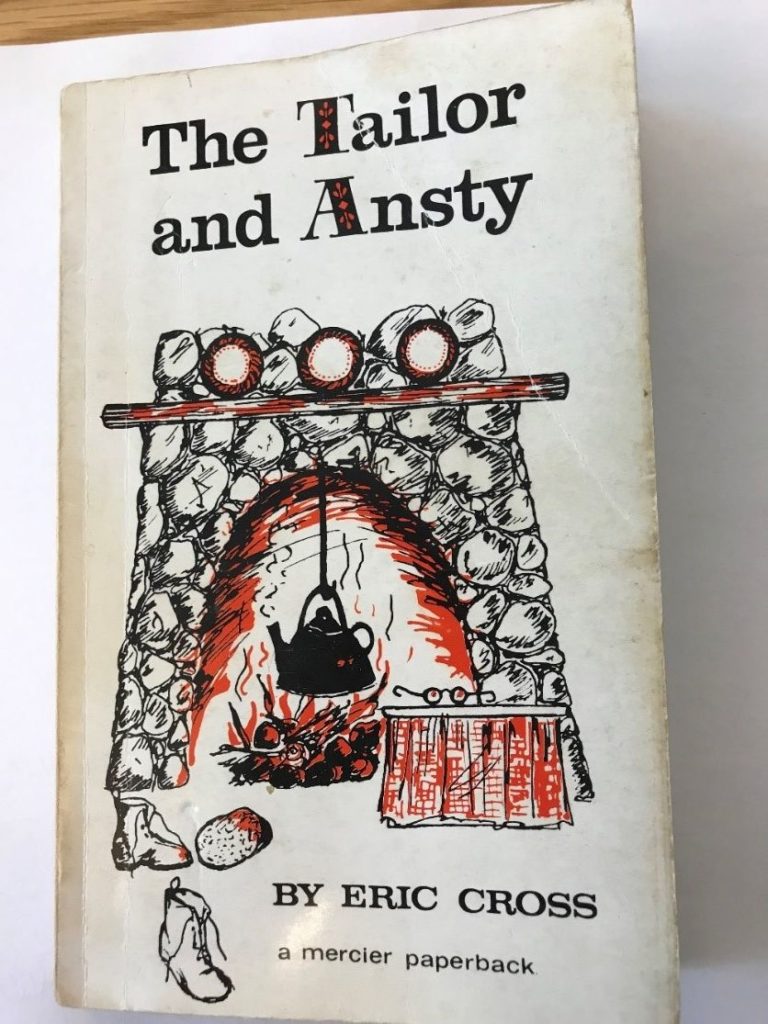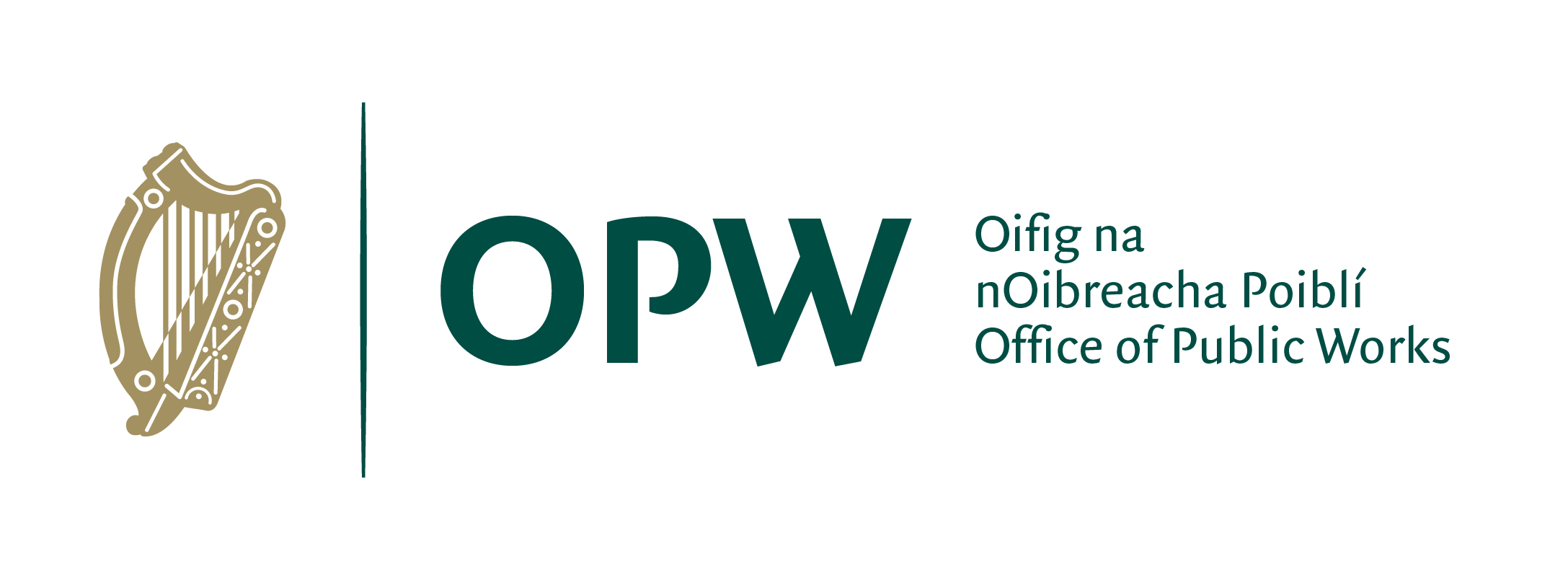By Don Ross, Office of Public Works, Farmleigh House.
I decided to prepare a presentation on the story of the tailor “Tim Buckley”, prompted by the bust of the man himself which takes pride of place on the mantle in the Benjamin Guinness library at Farmleigh House. I had read up a little on the story of the tailor and his wife Anastasia “Ansty” (1872-1947) and I was intrigued by the controversy surrounding the couple in the 1940’s. This revolved around a book called the “tailor and Ansty” written in 1942 by their friend, Eric Cross. The tailor was a man of many talents who lived in the small Gaeltacht community of Garrynapeaka, Gouganne Barra in County Cork. He would have described himself as a tailor by trade and indeed as a “dairy farmer” due to the fact that he was in possession a solitary black cow. But Tim was also a talented story teller and this particular gift brought him fame from far and wide. People would come to his cottage to sit and listen to the chat and banter and the stories that he told. Tim believed that they would go away much the wiser for having met him and having been taken in by his musings on whatever the topic of the day was.
 His stories revolved around the day to day life in the community, peppered with his thoughts on the local and international news of the day. That this news might already be old by the time that it filtered down to Gouganne Barra made no difference to the tale as Tim’s embellishments would offer a whole new slant on the story.
His stories revolved around the day to day life in the community, peppered with his thoughts on the local and international news of the day. That this news might already be old by the time that it filtered down to Gouganne Barra made no difference to the tale as Tim’s embellishments would offer a whole new slant on the story.
A typical example of the tailor’s outlook on life was the description of his first visit to talking pictures at the Astoria cinema. During the lead up to the main feature Tim gave a running commentary on the advertisement slot, regaling the audience with his thoughts on the products mentioned and their manufacturers. One example was well he knew the O’Learys who produced their own brand of lemonade. When the main feature which was described as “a matrimonial tangle on a pleasure cruise” was screened the tailor could not restrain himself from addressing the hero and heroine on screen. He gave advice to the actors in the film and when the couple engaged in a shy love scene, he had to give encouragement. “Hould her hould her! You would think by the shaping of her that she did not like it, but I tell you that they are all that way in the beginning. It’s a way of letting on that they don’t like it, when all the time they like it as a donkey likes strawberries.” The hero had disappointed the tailor because of his shyness and addressing the screen he said “Thon amon dieul! Man, if I was twenty years younger, I’d come up there and give you lessons”. The tailor and his wife Ansty were considered to have been very earthy in their dialogue and this trait was not uncommon among the ordinary practical people who lived in rural communities at the time. This was especially true among Irish speaking communities where translation took on a world of its own as descriptions from Irish into English could often differ with a little poetic licence.
When Eric Cross published his book “The Tailor and Ansty” there was huge controversy over it at the time as it was banned by the censorship board of the day because of its perceived indecency. In todays world the reasons for the ban would seem very trivial but back then in a very conservative Ireland it even merited a debate in the Senate which lasted four days.
As I was researching my information for what I would have considered to be a very informative and entertaining presentation on the bust I was delighted to find that the whole of chapter fourteen of Eric Cross’s book was devoted to the time Seamus Murphy spent with the tailor in preparation for its creation. I knew that the finished bust was a very fine representation of the tailor, probably one of Seamus’s most charming pieces and I liked to mention it during my tour of the house.

Chapter 14 describes the creation of the bust and the entertainment that it brought to the tailor’s cottage during its making. Nothing like it had ever happened before in Gouganne Barra and the tailor milked it for all that it was worth. The locals and indeed Ansty were suspicious of the project from the start as they could not fathom the need for such a disruption in their normal day to day lives. The tailor in his usual mischievous way said that two heads were better than one and that the bust would in time out last his current head. He also had them believing that he intended to have Seamus Murphy create a whole new body to go with the head. The innuendo in his musings together with the relative primitive beliefs of the day filled the local people with a suspicion which only added to the intrigue during the creation of the bust. Chapter 14 has brought the bust of the tailor to life for me. I have only to look at his wonderful features, then close my eyes and be transported back in time to the little cottage in Gouganne Barra and imagine what it was like during the time of its creation, a time that the tailor would describe life as being easy and slow. One of his favourite sayings was “take life fine and easy and life will be fine and easy with you”.

It is a privilege to be in the presence of the tailor’s “new head” whenever I give a tour of Farmleigh House. Sometimes when I look at him on the mantle, I am tempted to believe that maybe he gives me the odd wink of encouragement now and again, and then I know that the day will progress “fine and easy”.
The tailor’s full name was Tadhg O’Buachalla (Tim Buckley).
Eric Cross (1905-1980) was a journalist born in Newry Co. Down and he published his famous book the Tailor and Ansty in 1942.
Seamus Murphy (1907-1975) was born in Mallow Co. Cork. He was a stone carver and sculptor who specialised in working with limestone. He created busts of public figures including 5 presidents of Ireland, artists and friends. The tailor was in good company indeed when he was immortalised in bronze by his good friend who also created the couple’s tombstone down at Gouganne Barra in Co Cork.


